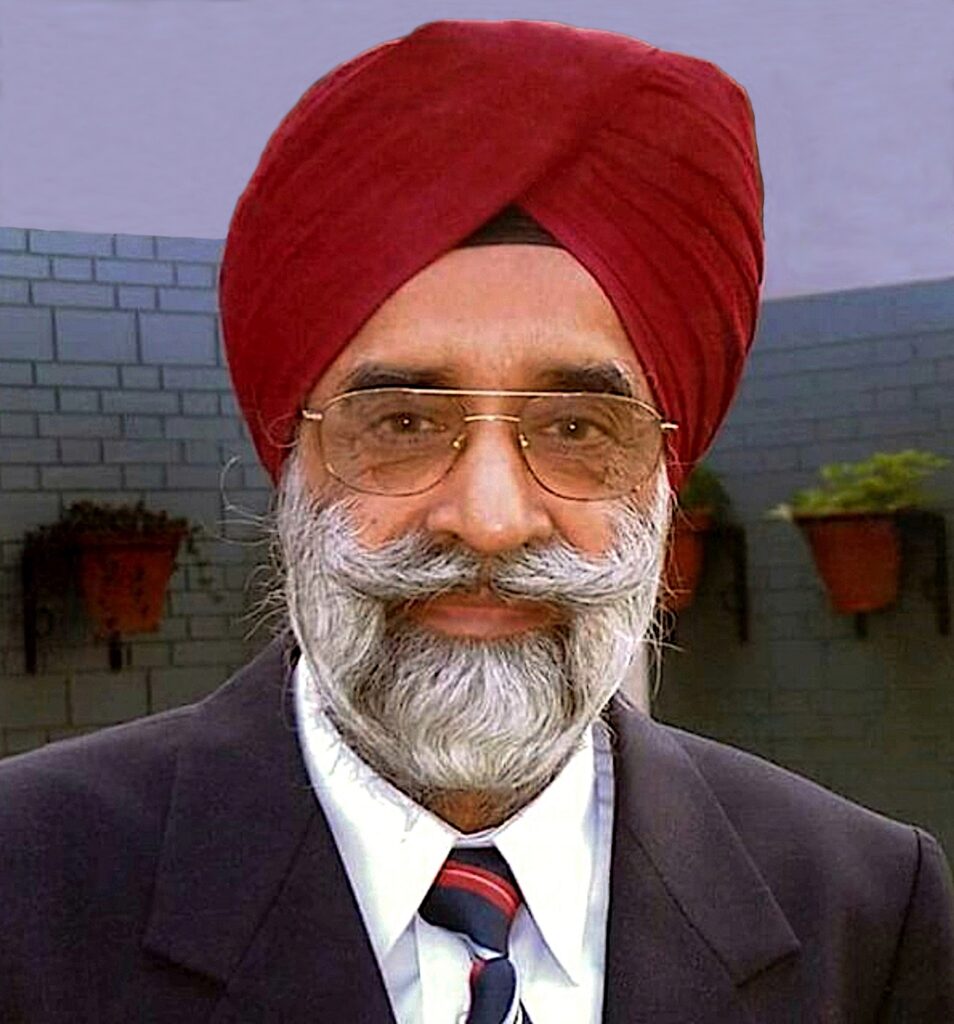
The history of modern Indian architecture revolves around nearly two hundred architects who have/had put effort into documenting and publishing their works. Unfortunately, all the so-called historians rely on this limited material, which is readily available and accessible. India is such a vast country with a rich treasure of outstanding masterpieces of contemporary architecture.
Thousands of brilliant architects have worked/are working tirelessly to enrich this treasure, but their works never came to the limelight. This is because people generally don’t write about their success stories, and others have no interest or time for that.
One such hidden gem of modern Indian architecture is Mohinderjit Singh from Amritsar. He is an architect par excellence, a sculptor, a painter, a Punjabi poet, a story writer, and a novelist. Above all, he is a very noble, humble, soft-spoken, and down-to-earth human being, but publicity-shy. He has produced hundreds of remarkable buildings that can be equated with those considered the best in the country, but they have never been published.
Mohinderjit Singh (b. 19-06-1934) has six decades of professional experience designing various types of buildings and complexes. He graduated from Panjab University, Chandigarh, with a Bachelor of Arts in 1955 and subsequently studied architecture, completing a B. Arch from the Maharaja Sayajirao University of Baroda in 1960. Mohinderjit Singh established his architectural practice in Amritsar in 1964. Before that, he was a lecturer in the Department of Architecture at the University of Roorkee, Uttarakhand. In 1979, he was appointed as an Architectural Consultant to Tashi Commercial Corporation, Bhutan, for commercial planning and interior design in Phuntsholing, Bhutan. During his 60 years of independent professional practice, Mohinderjit Singh has designed and executed various categories of projects. These include commercial and residential buildings, hospitals, schools, colleges, cinema halls, auditoriums, open-air theatres, factories, monuments, sports complexes, multi-storied office buildings, and housing colonies.
Mohinderjit Singh’s architecture is highly creative, functional, and aesthetically pleasing. Due to his exceptional contribution to architecture, he has been conferred with many prestigious awards and honours. Prominent among these are the State Award Parman Patra Gold Medal by the Government of Punjab in 1995, the Silver Plaque by Guru Nanak Dev University during the visit of the Dalai Lama in 1994, and the Best Architect Award of North India by Inside Outside magazine in 2011. Besides his professional field, Mohinderjit Singh remained active in social work through the Rotary Club Amritsar. He served the Club as Secretary, Vice President, and President, besides being Chairman of the Environment Improvement Committee of the Club. As Senior Vice Chairman, he also served the Academy of Fine Arts, Amritsar.

Since 1987, Mohinderjit Singh has been a consulting architect at Guru Nanak Dev University (GNDU), Amritsar. The magnificent campus of GNDU was initially designed by the noted architect Jasbir Sachdev. He prepared its master plan and designed several buildings from 1970 to 1986 in the first phase. After that, Mohinderjit Singh took charge of the second phase of development and designed dozens of buildings in GNDU’s Amritsar campus and its Regional Centre at Jalandhar. Prominent among these are Guru Nanak Dev Bhawan, Guru Nanak Heritage Centre, Maharaja Ranjit Singh Bhawan (Computer Science building), Asia House, Student Centre, and various sports facilities such as the Indoor Stadium, Swimming Pool complex, Cycling Velodrome, Hockey Stadium, and others.
The GNDU campus buildings, designed by Jasbir Sachdev in the first phase, are a perfect combination of exposed concrete and brick. Therefore, Mohinderjit Singh faced the challenge of matching his architecture with that of Jasbir Sachdev. With his ingenuity, creativity, and brilliance, Mohinderjit Singh did justice in providing a contextual architecture that harmonized perfectly with the existing one. He maintained the visual outlook of the buildings with exposed brick and concrete. As a result, it becomes difficult for onlookers to identify any differences between the two phases of development at GNDU.
There is a need for an extensive monograph to showcase Mohinderjit Singh’s complete works. However, for the time being, only two of his representative buildings in GNDU are discussed here briefly to shed some light on his way of conceptualisation. These buildings are Guru Nanak Dev Bhawan and Guru Nanak Heritage Centre.
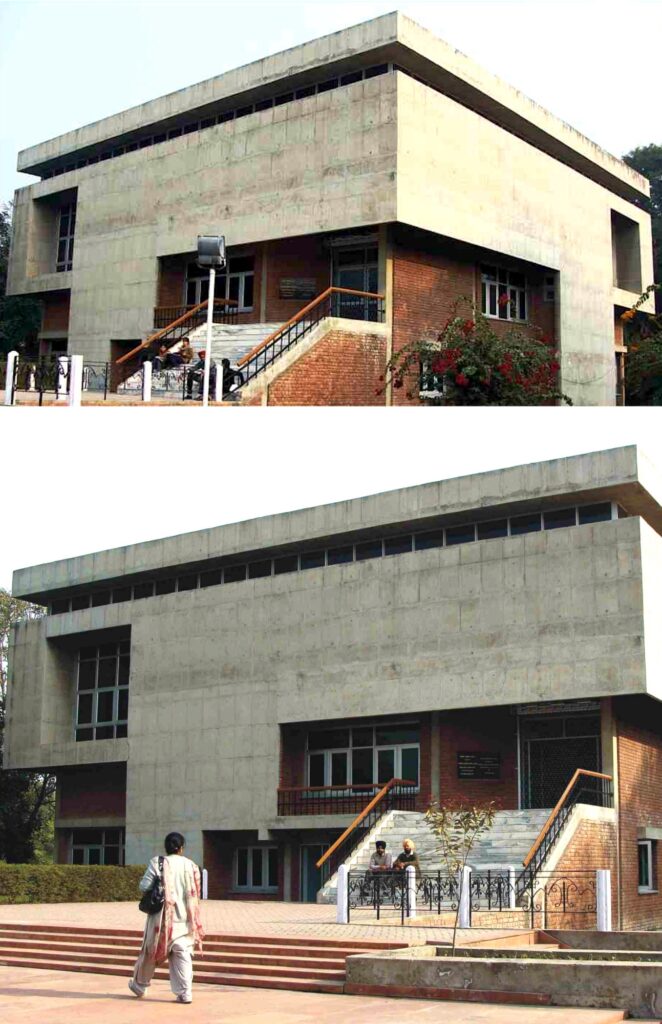
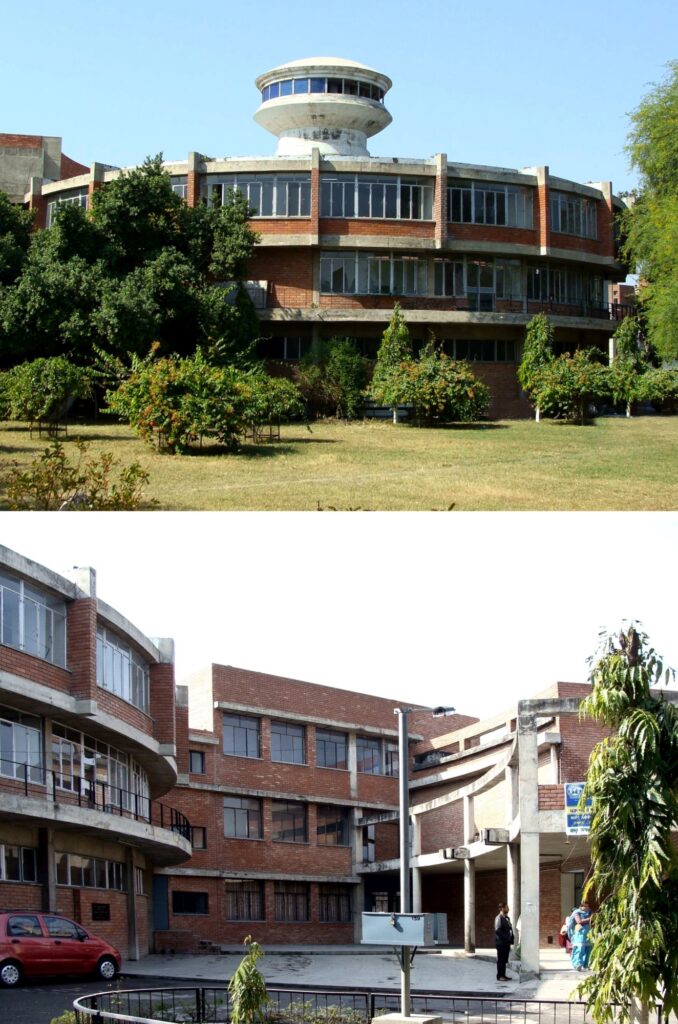
Guru Nanak Dev Bhawan is a themed building on the campus of GNDU. It is based on the concept of Kabir ji’s Shalok from Sri Guru Granth Sahib, ‘Ek Noor Se Sab Jag Upjiya…’. Its curves, simplicity, and singular form of three independent units represent universality. The building is formed by a circle and two segments of larger circles, with the centre of all the circles remaining the same. All structural components, such as walls, beams, and column placement, have one focal point where all axes meet, just as the universe originated from only the Lord (Noor). Similarly, this structure of Guru Nanak Dev Bhawan originates from one point, which lies in the centre of the main hall named Sangat Hall. Above this point, there is a light dome on top of the roof, made of fibreglass and concrete. The dome allows natural light to be transmitted to the centre of the hall.
The Guru Nanak Heritage Centre is a part of the recreational zone on the GNDU campus. It was designed as a museum to house paintings, manuscripts, and documents related to the life and history of Guru Nanak Dev. The client’s brief was to design an administration area, space for paintings and photographs, space for articles and other items of historical importance, manuscripts and computerized documents, and space for research scholars. The building was designed to provide independent space for each requirement without interfering with the others. A square form has been adopted, with the building having four different levels to accommodate each requirement. The space for research scholars is coupled with the area provided for manuscripts and computerized documents. A centralized grand staircase is provided so that each floor can be independently approached. The placement of floors is done in such a way that while standing on one floor, other floors are also in sight. The façade is made of exposed concrete and brickwork to maintain homogeneity with other university structures. This was the architectural approach taken by Mohinderjit Singh.
Chandigarh-based architect Surinder Bahga, who is an ardent admirer of Mohinderjit Singh’s works and knows him very well, says, “Mohinderjit Singh’s contribution to the architecture of Punjab and surrounding areas is immense. I have closely seen his work at the GNDU campus in Amritsar, initially designed by noted architect Jasbir Sachdev. Mohinderjit Singh has designed many new buildings in the second phase of developing the GNDU campus. His buildings are in complete harmony with those designed by Jasbir Sachdev in the first phase. As of now, it is challenging to identify which buildings are old and which were added by Mohinderjit Singh. He is saintly and god-fearing, lives a straightforward life, and keeps himself away from any publicity.”
The author felt honoured when he had the opportunity in 2009 to design the expansion of an existing Hockey Stadium in the GNDU campus, which was originally designed by Mohinderjit Singh. Designing a stadium in such a magnificent campus was not only exciting but also challenging. It was like working alongside a master. The stadium consisted of a small, open-to-sky seating pavilion and a multi-utility building located next to the playground. This utility building was, and still is, a double-storied linear block made of exposed concrete, in harmony with Jasbir Sachdev’s architecture on the campus. In the new design, the architect/author decided to preserve the existing utility building and seating pavilion as a mark of respect for Mohinderjit Singh’s architecture. Two additional seating pavilions were added on either side of the existing one, with sufficient space left between them. All three pavilions have been covered with a single giant canopy made of pre-engineered steel. The canopy has been designed to not touch the existing pavilion or the multi-utility building, in order to maintain their original character. It is hoped that Mohinderjit Singh will be pleased with this design proposal.
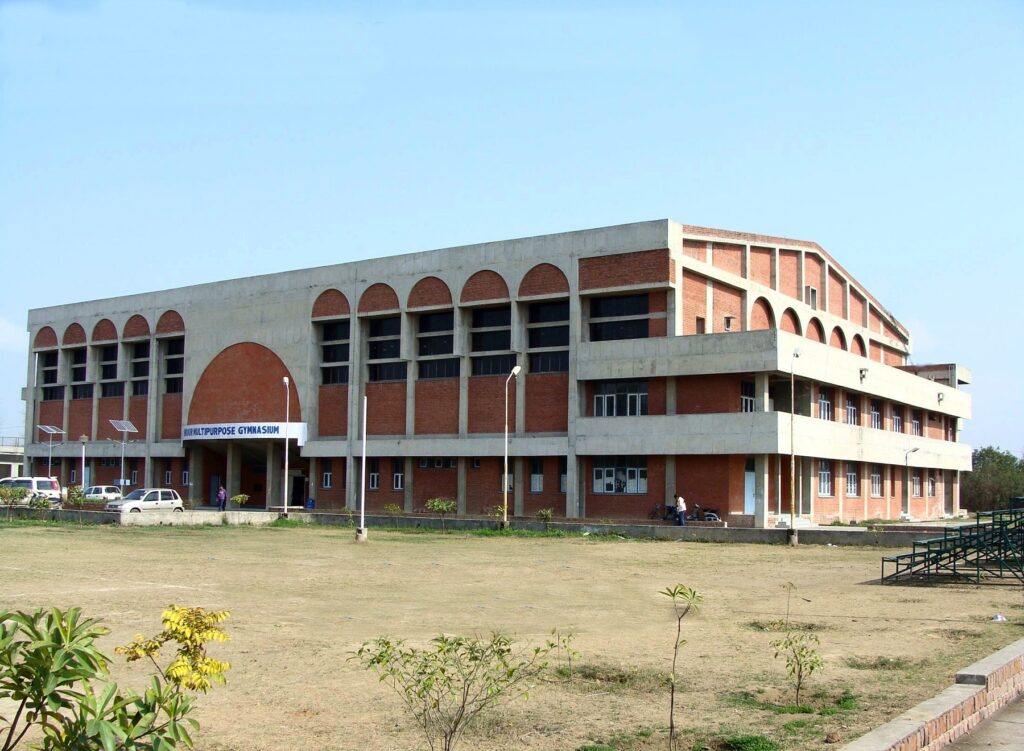
Mohinderjit Singh is not only an architect but also a brilliant sculptor. The combination of these qualities is visible in his architecture through the sculptural forms of the buildings he has designed.
In addition to buildings, he has also created many independent sculptures, which have been constructed in various places such as parks and plazas. One notable sculpture is located in the Rose Avenue Park in Amritsar. This art installation was designed and built in 1995 and is considered one of the city’s oldest sculptures. Another impressive creation by Mohinderjit Singh is the sculptural landscape of the front courtyard of his own house in Amritsar. The courtyard is artistically landscaped with free-flowing lines that demarcate paved areas, lawns, and flowerbeds. Carefully selected and creatively placed rocks, boulders, and pebbles add a sculptural touch to the landscape. The highlight of the place is a white sculpture depicting a mother and child in an affectionate pose. This larger-than-human-sized creation showcases the versatility of Mohinderjit Singh, who believes that any creative work, when done with concentration, is a form of meditation and brings godly bliss.
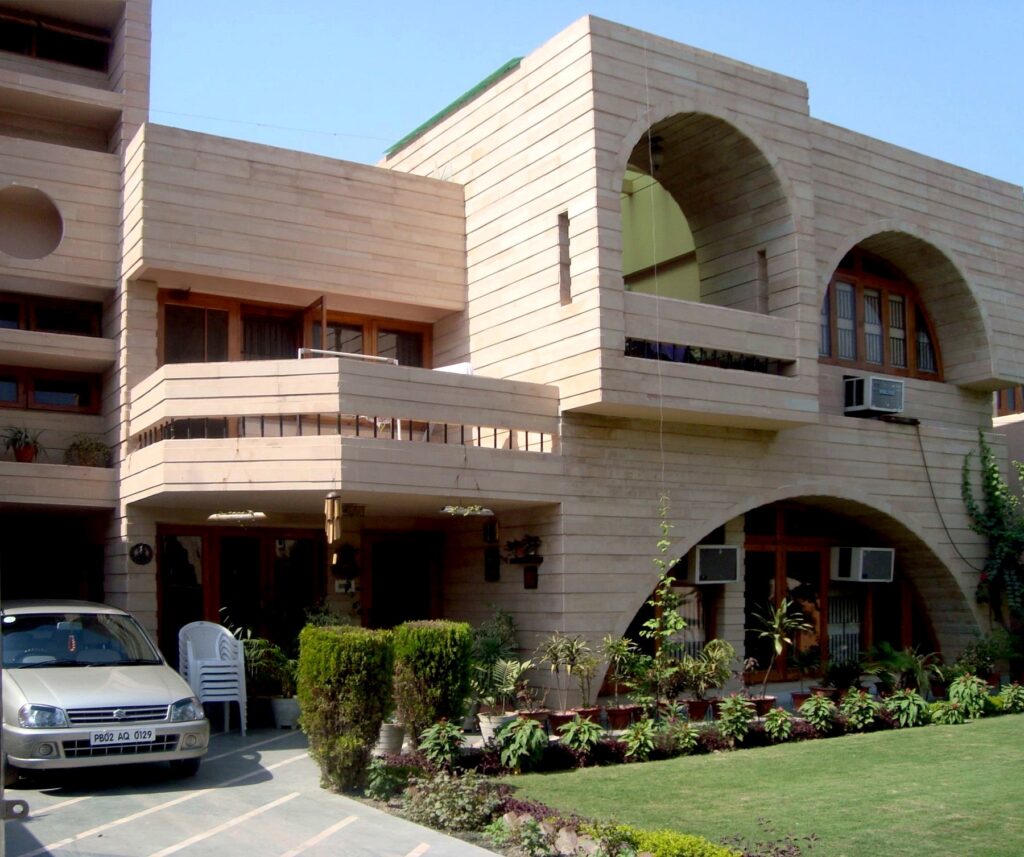

Amritsar-based architect and poet, Dalbir Singh, a close family friend of Mohinderjit Singh, says, “He is a very refined, soft-spoken, intellectual, and contented human being. In the initial years of his career, he was reluctant to engage in private practice as he was more interested in teaching at architecture institutions. Mohinderjit Singh’s father, engineer Dharam Singh, who dominated Amritsar’s architecture scene in the first half of the 20th century, compelled him to start his architectural practice there. Since then, he has created wonderful architecture; all his buildings are unique as he follows no fixed rules or trademark style. He loves curves and angles as design elements and specializes in architectural detailing. He has a strong preference for hand-drawn drawings and renderings. His favourite colours for architecture are light brown, pink, and off-white, and he dresses in the same colours. In addition to being a passionate architect, Mohinderjit Singh is also a talented painter, sculptor, Punjabi writer, and poet. If someone hurts him, he will write a poem or a short story to calm down instead of sharing his anguished feelings with someone.”
As explained by Dalbir Singh, Mohinderjit Singh has an artistic inclination and thus, painting, sketching, and perspective-making have always been his favourites. Since he began his architectural practice in 1964, he has consistently created 3-D perspectives of each building he designs and renders them with watercolours – his preferred medium. When the author was working on his book “Hand-Drawn Perspectives and Sketches” during the pandemic lockdown in 2020, Mohinderjit Singh was approached for his contribution. Despite the challenging times when all offices were closed, he managed to have some drawings framed for display. Defying his age, he opened the frames, removed the perspective drawings, had them photographed, and sent the photographs to the author for publication in the book. Such is the spirit of Mohinderjit Singh, who may be aged but is certainly not tired.
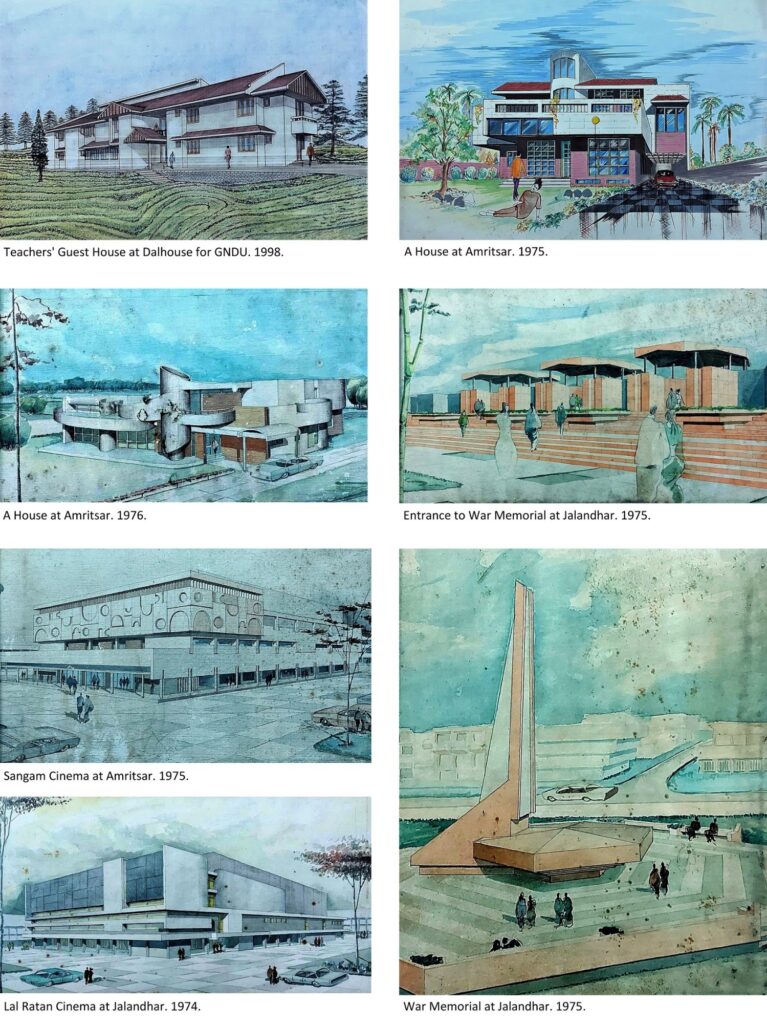

Besides professional drawings, Mohinderjit Singh always loves making oil paintings on canvas. Even now, at 90, he continues with this passion. He says, “This hobby keeps me young and healthy at this age.” His paintings usually capture expansive landscapes, lakes, rivers, seas, trees, flowers, and birds. The perfect layout, depth of field, level of detail, and use of vibrant colours make his paintings much more attractive, appealing, soothing, and refreshing to the eyes.

Yet another facet of Mohinderjit Singh is that he is a noted Punjabi litterateur (Sahityakaar) – a poet, story writer, and novelist. He has authored half a dozen books, which include Dabb, Sach di Bukal Vich, Chetna da Ik Pal, Kach Tutda Hai, Eti Maar Pai, and Ahisaas. Apart from this, he has been contributing short stories since 1952 to various Punjabi magazines like Lok Sahit, Parivartan, Sardal, and Kanwal. Mohinderjit Singh is a compassionate, introverted, and emotional person who seldom expresses his feelings to anyone. Instead, he prefers to translate them into his writings. Mohinderjit Singh will turn 90 in a few months, and considering his health, he has curtailed his professional activities to a greater extent. However, he is not tired yet and continues with his hobbies of painting and writing. Mohinderjit Singh penned a very touching and emotional poem in Punjabi to sensitively describe his graceful ageing process. He says, “Sensitivity, when tamed sensibly, can be a boon and creative.” This poem is reproduced here with its English translation by architect and poet Dalbir Singh.
| ਮੇਰੇ ਤਨ ਦਾ ਚੋਲਾ ਉੱਧੜ ਰਿਹਾ ਹੈ…, ਇਹ ਨਾ ਮੈਲਾ ਨਾ ਹੀ ਦਾਗੀ…, ਬਸ ਪੁਰਾਣਾ ਹੋ ਗਿਆ ਹੈ। ਜਦੋਂ ਕਦੇ ਇਹ ਜਿਥੋਂ ਪਾਟਾ, ਸਿਓ ਲਿਆ ਮੈਂ। ਪਰ ਹੁਣ ਥਾਂ ਥਾਂ ਤੋਂ ਛਿਜ ਰਿਹਾ ਹੈ…, ਨਿਗਾਹ ਵਿੱਚ ਹੈ ਚੋਲਾ ਉਸਦੇ, ਨਿੱਤ ਨਵੇਂ ਚੋਲੇ ਜੋ ਸੀ ਰਿਹਾ ਹੈ। | This worldly body of mine Is disintegrating, I saved it from spoils, I saved it from impurities, Just wearing out, is it, It got hurt, Sometimes, somewhere I became its healer, But now, it splits, Here n there, everywhere, Nature will be taking care of it, Who all the time Heals, repairs, creates. |
We wish Mohinderjit Singh a healthy, long and eventful life.



